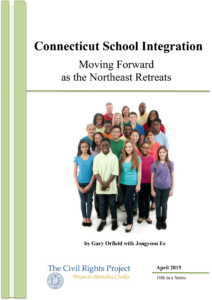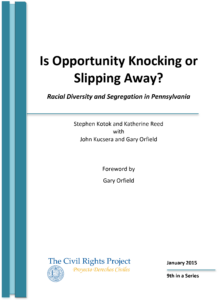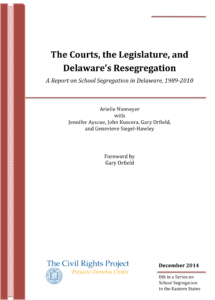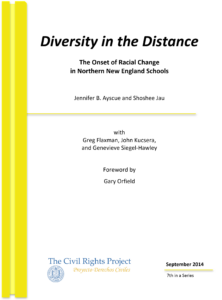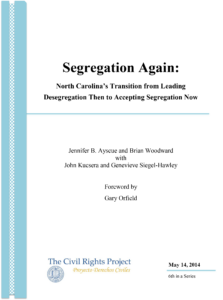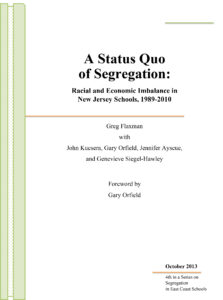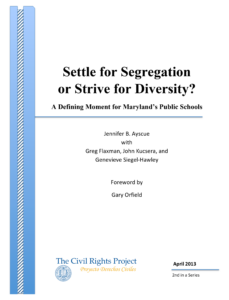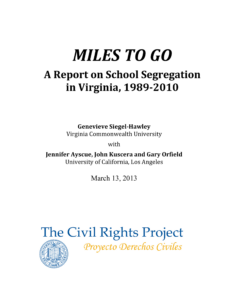About the Series:
This is a special series of reports on public school segregation in Eastern states. These studies explore trends in enrollment and school segregation patterns from 1989 to 2010 at the state and regional levels, including various metro areas for each state. The reports also document the history of school desegregation in each state and across its geographic regions, including key desegregation cases and remedies, when applicable.
1. Virginia
Miles to Go: A Report on School Segregation in Virginia, 1989-2010. Genevieve Siegal-Hawley with Jennifer Ayscue, John Kuscera and Gary Orfield. 13 March 2013.
“Despite Virginia’s long history with school desegregation, little political attention has been paid to the growing multi-racial diversity of the state’s enrollment and rising levels of isolation for its African American and Latino students. The report covers the past two decades and is the first to thoroughly explore trends in the state, its major metro areas and largest school divisions in the years since many of its districts were released from court order to desegregate.”
2. Maryland
Settle for Segregation or Strive for Diversity? A Defining Moment for Maryland’s Public Schools. Jennifer B. Ayscue with Greg Flaxman, John Kucsera, and Genevieve Siegel-Hawley. Foreword by Gary Orfield. 18 April 2013.
“Maryland, as one of 17 states that had de jure segregation, has an intense history of school segregation. Following the 1954 Brown decision, school districts across the state employed various methods to desegregate their schools, including mandatory busing in Prince George’s County, magnet schools in Montgomery County, and a freedom of choice plan in Baltimore. Although the districts made some progress in desegregating their schools, after plans that had the explicit goal of decreasing segregation ended, many of the schools in Maryland again reached high levels of segregation.”
3. Massachusetts
Losing Ground: School Segregation in Massachusetts. Jennifer B. Ayscue and Alyssa Greenberg with John Kucsera and Genevieve Siegal-Hawley. Foreword by Gary Orfield. 23 July 2013.
“The time has come for Massachusetts to get serious about dealing more effectively with its diversity. Because the nonwhite populations have historically been small and there is a general white attitude that the state is progressive and has done enough, the issues are often ignored.”
4. New Jersey
A Status Quo of Segregation: Racial and Economic Imbalance in New Jersey Schools, 1989-2010. Greg Flaxman with John Kucsera, Gary Orfield, Jennifer Ayscue, and Genevieve Siegel-Hawley. Foreword by Gary Orfield. 11 October 2013.
“New Jersey has a curious status regarding school desegregation. It has had the nation’s most venerable and strongest state law prohibiting racially segregated schooling and requiring racial balance in the schools whenever feasible. Yet, it simultaneously has had one of the worst records of racially imbalanced schools.”
5. New York
New York State’s Extreme School Segregation: Inequality, Inaction and a Damaged Future. John Kucsera with Gary Orfield. Foreword by Gary Orfield. 26 March 2014.
“New York has the most segregated schools in the country: in 2009, black and Latino students in the state had the highest concentration in intensely-segregated public schools (less than 10% white enrollment), the lowest exposure to white students, and the most uneven distribution with white students across schools. Heavily impacting these state rankings is New York City, home to the largest and one of the most segregated public school systems in the nation.”
6. North Carolina
Segregation Again: North Carolina’s Transition from Leading Desegregation Then to Accepting Segregation Now. Jennifer B. Ayscue and Brian Woodward, with John Kucsera and Genevieve Siegel-Hawley. Foreword by Gary Orfield. 15 May 2014.
“The report also finds students increasingly isolated by poverty, which greatly intensifies the educational problems caused by racial separation. In 2010, 50% of the state’s students were low-income. However, the typical black and Latino students attended schools with 59% low-income students while the typical white and Asian students attended schools with 58% middle-class students.”
7. New England (Maine, New Hampshire, Vermont)
8. Delaware
9. Pennsylvania
Is Opportunity Knocking or Slipping Away? Racial Diversity and Segregation in Pennsylvania. Stephen Kotok and Katherine Reed, with John Kucsera and Gary Orfield. 16 January 2015
“The state’s students of color are experiencing high and rising levels of segregation. Given the trends presented in this report, it is likely that segregation will only continue to intensify if nothing is done to address it.”
10. Connecticut
“Connecticut has not solved all the problems of racial inequality in education or other aspects of opportunity but it is unique in the Northeast of working creatively on the challenge and making some real, measurable progress. The Nutmeg state is a lighthouse for the region.”
